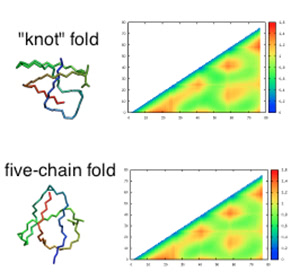The Help Stop TB project is turning out to be the most comprehensive study of mycolic acids ever undertaken, which will be of enormous value to all researchers who are interested in how these molecules protect bacteria. In this update, the researchers describe mycolic acid folds that have never been detailed before, and explain how they plan to continue their exploration of this new territory as the project continues.
Hello everyone, and thank you for contributing your computer time to Help Stop TB!
Background
The bacterium that causes TB (mycobacterium tuberculosis) has an unusual coating which protects it from many drugs and the patient's immune system. This coating includes fatty molecules called mycolic acids. The Help Stop TB project is using computer simulations to simulate the behavior of these mycolic acids in their many configurations to better understand how they protect the TB bacteria. This may help scientists develop better treatments for this deadly disease.
Studying Mycolic Acids
Since our last update in February, the team has been focusing on analysing the simulation data that we’ve received from World Community Grid, and coming up with meaningful conclusions about how the different configurations of mycolic acids can offer protection to the TB bacteria. The mycolic acid folds that we will talk about in this section have not been described before, and there has never been such an in-depth study of mycolic acid folds and their relations to one another.
We continue to analyze the data using the toolkit we have described in more detail in our previous project update. Briefly, the main analytical techniques we are using include a combination of PCA (principal component analysis) clustering, utilising a tool developed at the School of Pharmacy at the University of Nottingham, and distance matrix calculations. An example of the different information we can extract from distance matrix calculations can be found below.

This figure is an illustration of the distance matrix for two folds; a “knot” fold and a five-chain fold. These mycolic acid folds have not been described before. This figure shows that these different folds (left) are in fact connected and have dependencies with one another, as can be shown from their average distance matrices (right) that are quite similar visually. This similarity is further confirmed by root-mean-square deviation (RMSD) calculations.
These different folding patterns are currently in the process of being analyzed for the whole data set retrieved from World Community Grid. This data also includes simulations at different temperatures and for different solvents. Thus, it gives us the opportunity to analyse the effects of these parameters on the folding of different mycolic acids, which is important to understand how they eventually interact, fold, and behave in bacterial cell walls and influence the cell wall’s properties that offer protection to the TB bacteria.
The remaining challenge for the analysis of the World Community Grid data is to condense the vast amount of information into the important key features we are aiming for and the key question: why do distinct mycolic acids play such different biological and immunological roles? Stay tuned, we are working on it.
Future Plans
Future plans include letting our results “run dry” in a few months’ time. This will help us organize the vast number of simulations that we are currently running. More specifically, by running the results “dry” we will be able to investigate the progress of the simulations, fix any issues, create efficient backups, and then restart the simulations “clean”. Restarting “clean” will not only mean that we will have corrected any problems that might be occurring, but it will also mean that all simulations will restart again simultaneously which will guarantee a more efficient monitoring of their progress. Additionally, new simulations will be added to the workflow based on the information we have already gathered.
In terms of team news, Athina is in her last weeks of thesis writing and needs to focus on that 100% to make sure submission goes smoothly! Once we “run dry” and start our simulations “clean”, our team will change slightly, as Wilma will be stepping down. Having initiated the project, Wilma has been pleased to see the project launch and make good progress with the hard work of the Nottingham team and your contributions. The entire team is extraordinarily grateful for Wilma’s contribution and talent—without her, we would never have embarked on this ambitious project, nor would we have had the insight to continue to expand it. She has contributed immeasurably and we wish her the best for her future endeavours—may they be at least as successful.
That was all our news for now! Thank you again for your contributions so far!
Related Articles
- Help Stop TB Researchers Begin First Stages of Data Analysis
- Help Stop TB Team Selects Data Analysis Tools
- Help Stop TB Researchers Seek New Team Members
- A Graduation, a Paper, and a Continuing Search for the Help Stop TB Researchers
- Help Stop TB Team Continues Learning and Searching
- Help Stop TB Researchers Welcome New Team Member